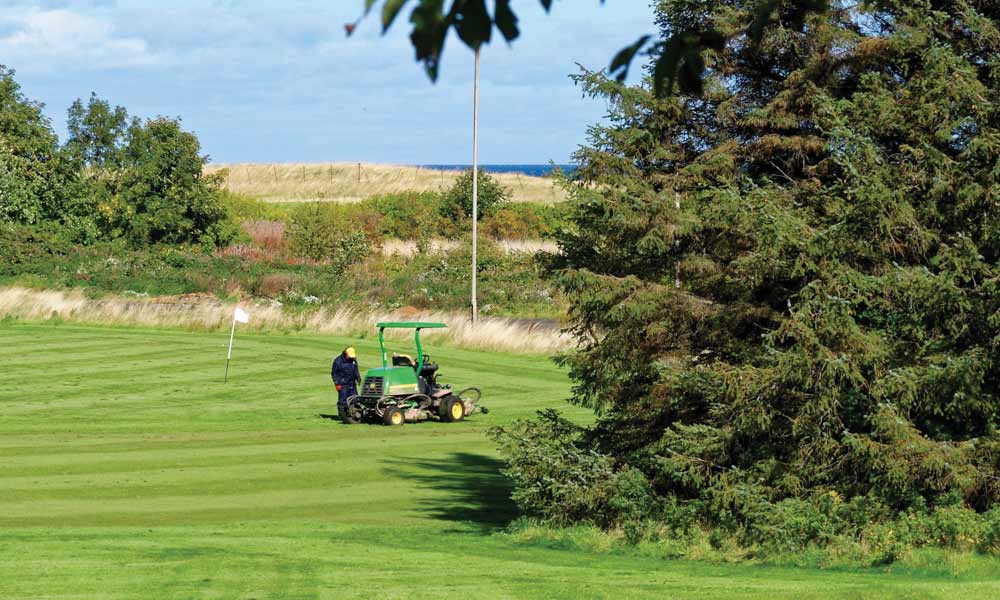

I could hear the sound of the shotgun that sent the golfers across the course to their designated starting tee. The pressure was high as the golfers headed towards us from one direction and The Superintendent from another. In the nick of time, like getting a stalled car off the railroad tracks, the safety switch plug that the operator had broken off was reconnected and the mower was sent on its way.
This story was a little dramatic, but the point was made about the value of quick troubleshooting and repair. In that scenario, the broken-down mower was a result of operator error.
Let’s run through the scenario as if the breakdown was more than just operator error. Again, we have an engine that will not start and run. This condition can be the result of a mechanical failure of an engine component or the engine itself. Before we can effectively troubleshoot the engine, I want to look at what makes an engine tick. There are many books written on the subject of engine theory and operation. I am going to cover some of the basics of engine operation to give a glimpse of what is happening when an engine is humming along at 3600 RPMs or not at all.
The type of engine we are troubleshooting is a four-stroke air-cooled carbureted V-Twin. A four-stroke engine is also called a four-cycle engine, but a four-cycle engine is not another name for a four-cylinder engine. The engine we are troubleshooting has two spark plugs, with one per cylinder. Therefore, it is a two-cylinder engine. It is common within the golf industry for equipment to be powered by one, two, three, or four-cylinder engines using gasoline or diesel for fuel.
The origin of today’s modern and efficient engine began in 1876 when Nicolaus Otto designed the four-cycle internal combustion engine, which became known as the Otto Cycle. The four-stroke name is derived from the action of the piston inside the cylinder as it moves upward or downward to complete a stroke. Four strokes complete one cycle. During this one cycle of the engine operation, the camshaft opens and closes the intake and exhaust valves at the right time while completing one revolution, as the crankshaft rotates and moves the piston up and down in the cylinder while completing two revolutions. The full travel of the piston in either direction is a stroke. There are four strokes that occur in an engine to complete one cycle of engine operation. The cycle of four strokes is repeated continuously as the engine is running. The following action occurs within each stroke.
Intake Stroke – The piston is moving downward in the cylinder while the intake valve is open and draws the air and fuel mixture into the engine, while the exhaust valve is closed.
Compression Stroke – The piston is moving upward in the cylinder compressing the air/fuel mixture while both the intake and exhaust valves are closed.
Power Stroke – The piston begins to move downward again as the ignition sends a spark through the spark plug and ignites the compressed air/fuel mixture.
Exhaust stroke -The piston is moving upward in the cylinder while the intake valve is closed, and the exhaust valve is open to allow exhaust gases from combustion to push out through the exhaust manifold and into the muffler.
There are three conditions that must be present to allow an engine to start and continue running. These conditions are fuel, ignition, and compression.
Let’s look at each of these conditions and how to perform some basic troubleshooting. Remember to use caution when working around any fuel, Where safety glasses and no open flames.
Gasoline/Fuel
- Check for the gasoline level in the tank and verify that the fuel tank shut off valve is open. If the tank is empty add gasoline and try restarting. Again…a no-start situation.
- Remove the air cleaner and give the intake of the carburetor a little shot of starting fluid while cranking the engine. At this moment the engine starts and runs for a few seconds. This tells us that ignition and compression is present, but no gasoline is getting into the engine.
- From here, disconnect the fuel line from the carburetor and direct the open fuel line into an empty container while cranking the engine. The gasoline should flow out in a pulsing action as the engine cranks over. If so, the fuel pump is good. If there is no flow, most likely the fuel pump is defective and needs to be replaced. Also at this time, inspect the pulse vacuum line attached to the pump for any cracks. The fuel pump is operated from a pulsating negative and positive pressure from inside the engine as the piston goes up and down in the cylinder. We will move on as the fuel pump is found to be good but we still have a no-start situation.
- This leads us back to the carburetor and why is there no fuel getting into the engine? At the base of the carburetor is a small 12-volt solenoid that operates a plunger that opens and closes the main fuel jet inside the carburetor. Listen carefully while turning the ignition key to the run position. You will hear a faint click as the solenoid pulls in the plunger to open the main jet and allows fuel to flow. In our case, we cannot hear the click. Now take a test light and check for power at the solenoid wire lead. If power is present, the solenoid needs to be replaced, and the engine will start and run.
Ignition
- Remove a spark plug and place the thread base against the engine ground. Crank the engine and look for the presence of a spark. At this point…no spark and a no start engine.
- When the ignition switch is turned to the off position, this grounds the ignition coils and shuts off the spark to the spark plugs. The next step is to disconnect the ground wire on the side of the engine blower housing. Again, crank the engine. Now we have a spark and the engine should start and run.
- The results of disconnecting the ground wire tell us there is a problem in the key switch, relays, or wiring.
- At this point, we would move into electrical troubleshooting.
- Another situation that can occur is a sheared flywheel key. This would still allow a spark, but at the wrong time, and would result in not starting or backfiring from the carburetor or muffler.
Compression
The easiest way to check compression is with a compression tester. Follow the instructions in the test kit to perform this test. A more advanced tool is a cylinder leak down tester. This test will pinpoint the compression failure, whether it is bad rings or valves.
A total loss of compression can also be detected without any test tools when the starter can spin the engine over freely without any resistance. This can be confirmed by removing the spark plugs and blocking the spark plug holes with your thumb while cranking the engine. If you can keep your thumb in place, there is a loss of compression. This indicates a broken connecting rod, piston, or valve damage.
Troubleshooting can be confusing and overwhelming. So, when your mower is down, keep it simple and remember all three conditions must be present for the engine to start and run. Again, they are fuel, ignition, and compression.
Feel free to submit your comments, questions, and ideas to Brian Duffy at mxk92@yahoo.com.
Brian Duffy’s career spans thirty five-plus years in the golf industry. With a diverse background of working on golf courses and turning wrenches on all types of equipment. Plus teaching Golf Course Equipment Mechanics and progressing into turf equipment sales and service. For any questions, comment or ideas contact me at mxk92@yahoo.com
Recent Posts
South Carolina State Leaders Honor Green’s Superintendent Career
South Carolina’s House of Representatives today honored the career of golf course superintendent Chuck Green.…
Branson, Missouri: 5 Reasons Why it is a Must-Visit Travel and Golf Destination
Branson, Missouri, is booming as a must-visit destination for golf enthusiasts and travelers alike. Nestled…
Preview more than 1,000 rounds of golf available in GCSAA’s Rounds 4 Research online auction
The Golf Course Superintendents Association of America (GCSAA) Rounds 4 Research program offers golfers the…
EcoBunker Synthetic Revetting More Sustainable than Natural Turf*
*A recent report by the Welsh government has found that EcoBunker synthetically revetted bunkers have…
SiteOne® Hires Dan Carrothers as VP, Agronomic Business Development
SiteOne® Landscape Supply is pleased to announce Dan Carrothers as the new Vice President for…
Superintendents Online Turf Directory – EVERYTHING TURF
Our online directory, directory.GolfCourseTrades.com is the go-to resource for the busy superintendent. It is your opportunity…


